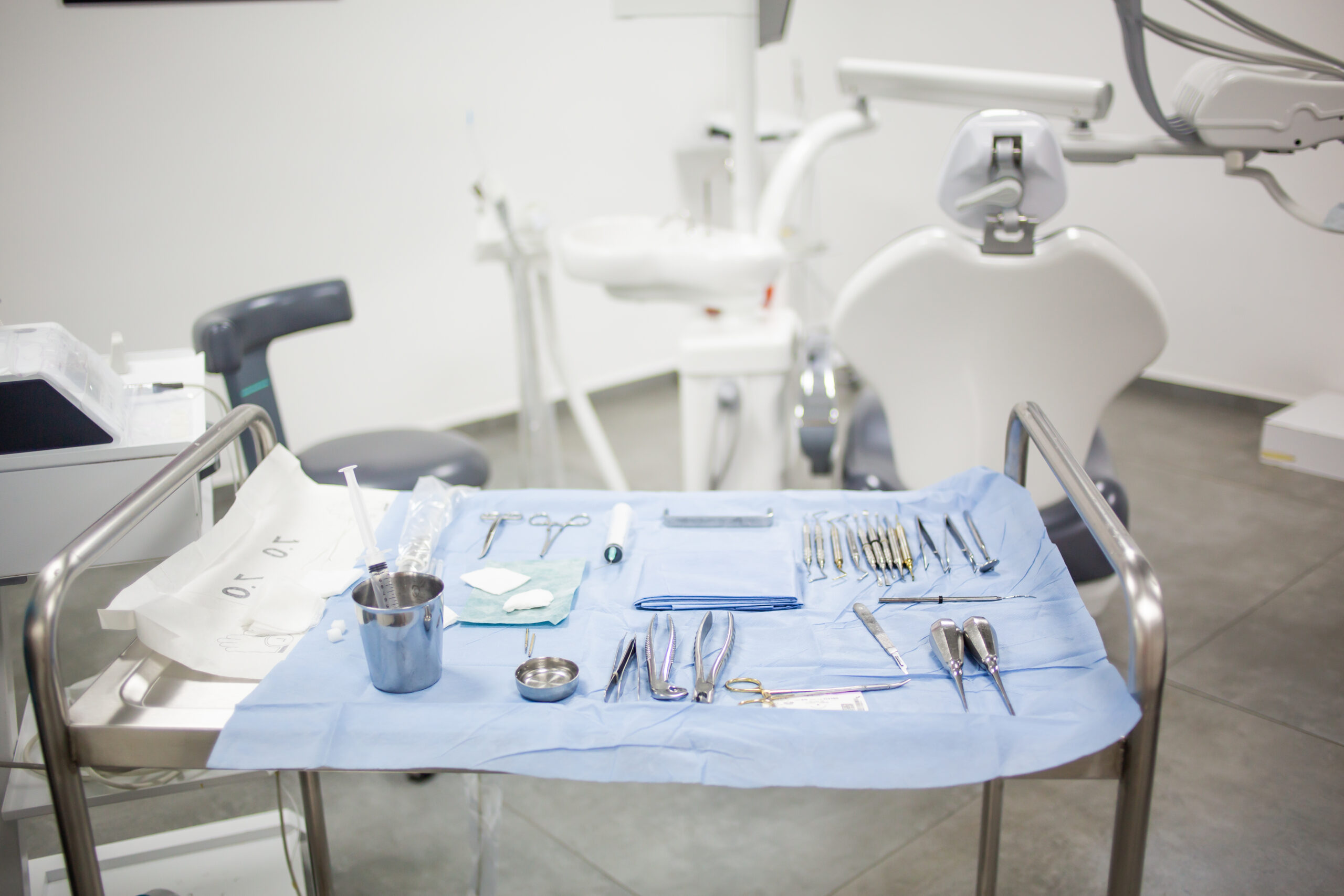How Poor Documentation Led to Wrong-Side Surgery
Case Study
Marc Leffler, DDS, Esq.
December 6, 2021
Reading time: 7 minutes

Background Facts
The insured general dentist had been seeing and treating a 29-year-old male patient since the patient was in his teens, by way of infrequent visits over time, with the patient generally appearing only for an occasional check-up presentation, having never had any restorations. On such a visit after a 3-year hiatus, with the patient asymptomatic, the dentist obtained a full mouth series of radiographs, on which he visualized a well-circumscribed, well-demarcated, radiolucent lesion that extended from the roots of teeth #17 and 18 – both of which looked to be partially “eaten away” – posteriorly and inferiorly toward the angle of the mandible, although there was no clinical expansion of the mandible. The dentist was unable to see the entire extent of the lesion, so he immediately referred the patient to a board-certified oral and maxillofacial surgeon for further evaluation and any required treatment; with the patient’s approval, the dentist emailed the patient’s entire set of records and radiographs to the oral surgeon, with all prior radiographs of the area appearing normal.
Following examination the same day, the oral surgeon took a panoramic radiograph that showed the lesion extending to the inferior border, and performed an incisional biopsy of what he stated on a biopsy requisition to be a “right posterior mandible lytic lesion”, which was reported several days later as an odontogenic keratocyst (“OKC”). That report incorrectly repeated the lesion’s location as the posterior right mandible, but the oral surgeon created no documentation of his having realized the error. When the patient returned to the oral surgeon the following day, he was advised that, due to the high rate of recurrence of OKCs, the extent of the lesion required that a complete resection of the mandible from the first bicuspid to the lower third of the ramus be performed, with immediate reconstruction using plating and a bone graft taken from the patient’s iliac crest. No chart entry stated the side of the potential surgery. The patient agreed and hospital surgery was scheduled for two weeks later. The oral surgeon updated the general dentist regarding the diagnosis and plan.
On the day of surgery, the oral surgeon was stuck in a traffic jam, causing him to be late at the hospital. While on route, he called the operating room waiting area and spoke to a nurse there, asking that his patient sign a consent form for right mandibular resection and reconstruction with hip graft and plating; the nurse agreed. The nurse discussed with the patient that he would be obtaining the patient’s signed consent for right side jaw surgery, and completed a proposed consent form listing those as the procedures. Upon reading the form, the patient corrected the nurse, advising him that the lesion was on the left side, so the nurse left the unsigned form for right side surgery in the chart and created a new one for left side surgery, which the patient signed and which was also placed in the chart.
Upon his arrival at the hospital, the surgeon briefly greeted the patient upon passing through the waiting area, and asked that the patient be brought into the operating room while he changed into scrubs. The operating room supervisor pointed out to the oral surgeon that his lateness had backed things up, so he should “move things along”. After quickly changing his clothes, he went to the OR suite, where he signaled to the anesthesiologist to put the patient to sleep while he scrubbed and gowned. The oral surgeon had brought with him only the pathology report and a print-out of the panoramic film, which did not have “L” or “R” markings. As he began to prep the right side for surgery, the nurse pointed out that the patient was definitive that the surgery was to be performed on the left side; the surgeon was adamant that the surgery was to be done on the right side and that the patient was incorrect, pointing to the pathology report describing a right OKC. The nurse did not question further. The oral surgeon performed a block resection from tooth #28 to the right ramus, sacrificing the right inferior alveolar nerve, and reconstructed the site with a bone plate and a graft from the patient’s iliac crest. The surgery proceeded uneventfully from a technical standpoint.
When the patient’s wife saw her husband that evening, she was shaken to see that the surgery had been performed on the wrong side. The patient became upset and distraught for the remainder of his time in the hospital, and refused to see the oral surgeon to be checked, asking instead that another surgeon on staff follow him until discharge. After seeing that other surgeon in the office following discharge, and after adequately recovering from surgery, the patient presented for the identical surgery on the left side, which sacrificed the left inferior alveolar nerve and which required using another reconstruction plate and a graft from the other hip. His facial deformities were quite apparent, and his functioning was grossly deficient, leading to a 40-pound weight loss in the year before implant placement and restorations could begin.
Legal Status
The patient and his wife retained well-respected and experienced attorneys to file suit against the oral surgeon (for performing the incorrect surgery), the hospital (for failing to engage in a proper pre-surgical protocol), the oral pathologist (for reporting the OKC as being on the incorrect side), and the general dentist (for having made a referral to an “incompetent” oral surgeon).
Litigation Events
Attorneys for the general dentist submitted a motion to the court, seeking dismissal, arguing that their client did everything that the standard of care required, namely making a timely referral to a board-certified specialist; the court agreed and dismissed the general dentist from the case. Similarly, attorneys for the oral pathologist made a corresponding motion, claiming that the standard of care for oral pathologists did not require confirmation of the location of the examined lesion, but instead allowing the pathologist to rely upon the practitioner who performed the biopsy for that information; the court concluded that this was a question of fact for a jury, and kept the pathologist in the case. The claims against the oral surgeon and the hospital were settled for substantial amounts, leading the patient’s attorneys to drop the sole remaining claim against the oral pathologist.
Takeaways
Although the general dentist was ultimately let out of the case, this situation makes clear that any practitioner involved with patient care may be made part of a lawsuit, and be forced to bear all that goes along with being a defendant in a malpractice action. Here, the dentist completely abided by the standard of care, and the court agreed, but an important lesson is to make referrals timely (as was done here) and wisely, considering experience, credentials and background of the practitioner to whom a referral is made.
It is not uncommon for dental professionals to run late and feel pressured to regain control of their daily schedules, whether to appease patients, staff members, or hospital administrators. But that can never serve as an excuse for not taking a “time out” prior to performing anything irreversible, to assure that the patient, treatment location, and procedure are all correct; if there is any doubt at all in this regard, steps must be taken to confirm complete accuracy, even if that means abandoning the patient’s care for that day altogether, and even if that means worsening already-existing schedule delays.
Because OKCs tend not to be expansile from the standpoint of splaying out the cortical plates and making the jaw appear to be “swollen”, the lesion provided no external clue as to which side contained it. It is frequently the case that bony and/or periapical lesions show no external signs of their presence, so practitioners act carefully by assessing all diagnostic factors before suggesting or rendering treatment.
The informed consent process here was relegated by the oral surgeon to a hospital nurse who was unfamiliar with the prior history of events. Best practice guidelines dictate that the practitioner about to perform the procedure personally obtain informed consent, rather than having some other person do it instead. Had the oral surgeon obtained informed consent, there would have been an appropriate forum for patient and doctor to fully come into agreement regarding the details of the surgery about to take place, including the correct location.
The oral surgeon in this case made a critical error in documentation to the oral pathologist, and that error repeated itself at every step following. (This is commonly seen in electronic medical records when incorrect documentation of history, diagnosis or procedure is repeated over and again, because practitioners “cut and paste” from earlier entries to save time.) If the panoramic here had been labelled “L” or “R”, of if the patient had any restorations to differentiate between the two sides, this serious problem might have been avoided, but neither of those situations existed, nor can these types of circumstances be counted on to derail an error in the making. In the end, the negligence in this case was an easily avoidable mistake, based not upon lack of ability or an incorrect choice between various options or a known risk which came to fruition, but upon failing to assure the correctness of a surgical procedure with permanent effects. Measure twice, cut once.
Note that this case presentation includes circumstances from several different closed cases, in order to demonstrate certain legal and risk management principles, and that identifying facts and personal characteristics were modified to protect identities. The content within is not the original work of MedPro Group but has been published with consent of the author. Nothing contained in this article should be construed as legal, medical, or dental advice. Because the facts applicable to your situation may vary, or the laws applicable in your jurisdiction may differ, please contact your personal or business attorney or other professional advisors if you have any questions related to your legal or medical obligations or rights, state or federal laws, contract interpretation, or other legal questions.
Additional Claims content

Communication Mishap Between Providers Leads to Malpractice Suit
Claims
Proper communication between dental providers is essential when referring a patient for a procedure. In this case study, a dentist refers a patient to an oral surgeon for a tooth extraction, but a miscommunication between the providers causes the oral surgeon to extract the wrong tooth.

Loss of Taste After Procedure Leads to Lawsuit Against Dentist
Claims
Informed consent is one of the most important aspects of dental care. When performing a procedure, ensuring through verbal agreement and documentation that a patient understands all possible negative outcomes is the best way to protect yourself against claims of negligence and malpractice lawsuits. In this case study, a dentist’s informed consent documentation becomes key when she is sued over a patient’s loss of taste after a procedure.

Numbering System Miscommunication Leads to Extraction Mistake
Claims
In dental practices, there are a variety of numbering systems that are used to identify teeth, which can lead to miscommunication and mistakes. In this case study, an orthodontist refers a patient to their general dentist for a tooth extraction. Upon receipt of the referral, there is a miscommunication with the orthodontist’s staff and the dentist mistakenly extracts the incorrect tooth.
This document does not constitute legal or medical advice and should not be construed as rules or establishing a standard of care. Because the facts applicable to your situation may vary, or the laws applicable in your jurisdiction may differ, please contact your attorney or other professional advisors if you have any questions related to your legal or medical obligations or rights, state or federal laws, contract interpretation, or other legal questions.
MedPro Group is the marketing name used to refer to the insurance operations of The Medical Protective Company, Princeton Insurance Company, PLICO, Inc. and MedPro RRG Risk Retention Group. All insurance products are underwritten and administered by these and other Berkshire Hathaway affiliates, including National Fire & Marine Insurance Company. Product availability is based upon business and/or regulatory approval and/or may differ among companies.
© MedPro Group Inc. All rights reserved.